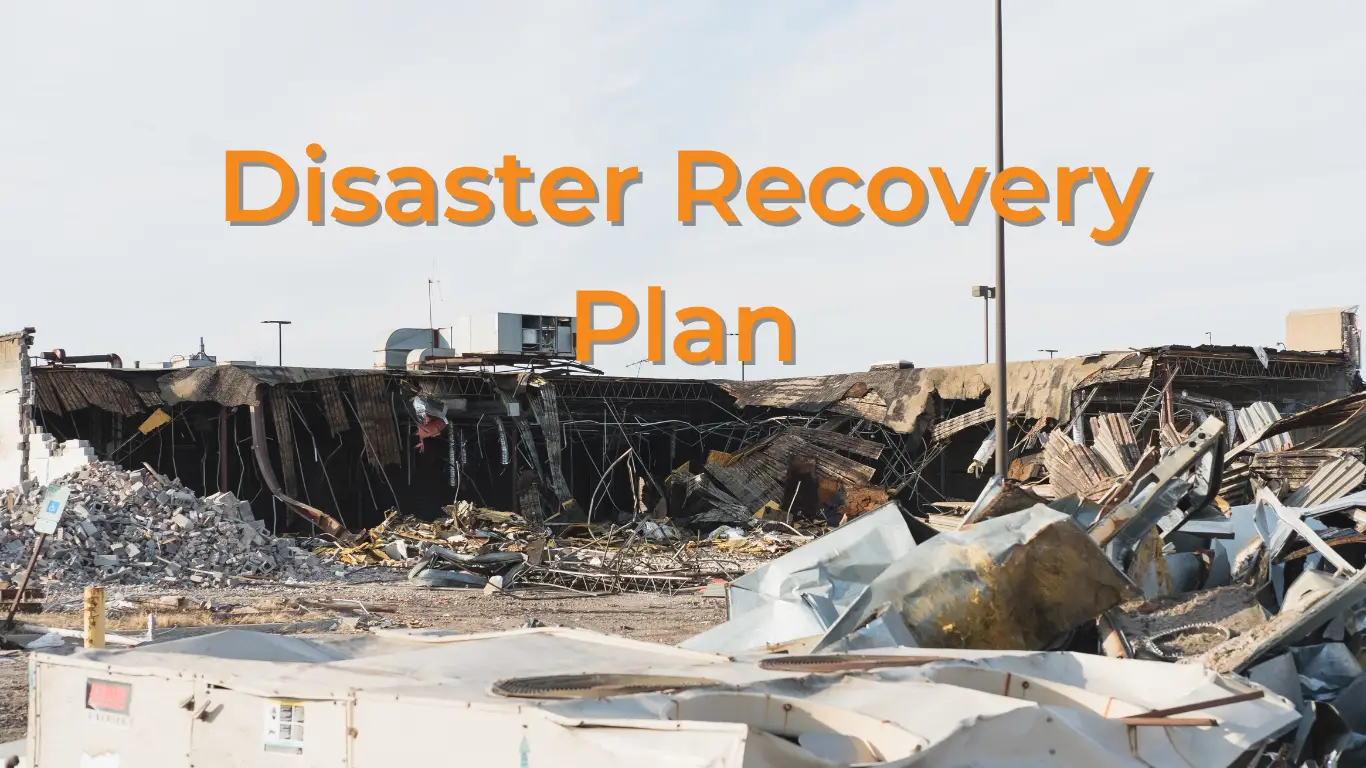Everything you should know about Disaster Recovery Plan
Are you a business or IT professional preparing for an unexpected disaster? If so, this blog post is for you! Having the right information and backup plan can be the difference between staying afloat during an outage or suffering massive business damages.
In this blog, we’ll explain the disaster recovery plan (DRP) meaning, why it’s vital to your business success, and how to create one. Disaster recovery procedures have become extremely important in today’s digital world as companies depend more and more on their data.
Keep reading to learn exactly what goes into crafting an effective DRP and find out if yours would hold up against a real-world disaster!
What is Disaster Recovery?
Disaster recovery refers to the set of processes and procedures designed to help an organization resume normal operations in the event of a natural or man-made disaster.
A disaster recovery plan is a critical business operations of any organization's overall recovery strategy for major goals, maintain business continuity plan and minimize the impact of disruptions.
This DR plan typically involves identifying potential risks and vulnerabilities, prioritizing critical systems and operations, and creating a detailed roadmap for recovery and restoration align with the disaster recovery policy.
Effective disaster recovery planning requires a thorough understanding of an organization's unique needs and challenges, as well as a commitment to ongoing monitoring and testing to ensure readiness in the face of unexpected events.
By taking proactive steps to mitigate risks and prepare for the worst, businesses can protect their people, assets, and reputation when disaster strikes.
What is a Disaster Recovery Plan (DRP)?
A disaster recovery plan (DRP) can be defined as a comprehensive strategy that outlines a clear course of action in an emergency. It includes the steps and procedures necessary to get your business back up and running in the quickest time possible.
These DR plans are critical for any organization, regardless of size, industry, or location, and can mean the difference between survival and failure in the face of an unexpected event.
Also, A disaster recovery plan is a documented procedure that outlines the actions to be taken by an organization in the event of a disruptive event.
A DRP is designed to help businesses recover from natural disasters, cyberattacks, system failures, and other types of disruptions that could cause serious harm to their operations.
A good DRP outlines the steps that need to be followed to minimize the impact of a disaster on your business.
What is a Disaster Recovery Planning?
Disaster recovery planning is the process of preparing for and recovering from a disaster that causes interruptions in business continuity.
The purpose of a DRP is to minimize the impact of a disaster by creating a document that outlines backup procedures for restoring systems, services and processes.
It typically includes steps for backing up data, identifying critical applications, establishing recovery time objectives (RTOs), and setting up an alternate work site.
A well-designed DRP can help organizations quickly recover from disasters and prevent significant losses in productivity, reputation, and revenue.
In essence, a DRP is an essential tool for businesses to minimize the consequences of an unplanned event and ensure business continuity planning and business impact analysis.
Types of disasters for which a Disaster Recovery Plan can help prepare
Whether it's a natural disaster like a hurricane or a man-made disaster like a cyber attack, the consequences can be devastating. That's why having a DRP in place is so important.
DR plan helps organizations prepare for all kinds of disasters, minimizes the impact of those disasters, and helps the organization recover as quickly as possible.
By creating a Disaster Recovery Plan, organizations can be better prepared to deal with unexpected situations, protect their assets and people, and maintain business continuity plan.
Disasters come in all shapes and sizes, and they can strike at any time, which may include:
-
Application failures
-
Communication failures
-
Power outages
-
Natural disasters
-
cyber attacks
-
Data center disasters
-
Building disasters
-
Citywide disasters
-
Regional disasters
-
National disasters
-
Multinational disasters
Being proactive in planning for these potential disasters helps organizations mitigate risks and ensure business continuity.
Why it is important to have a disaster recovery plan?
Businesses are complex entities that have multiple moving parts, each of which is critical to the overall success of the company.
With the ever-increasing reliance on technology, it, too, has become an essential component of any business.
However, while technology provides numerous benefits to businesses, it also brings inherent risks - particularly when it comes to data loss. Disasters can strike at any time, and businesses can quickly lose everything.
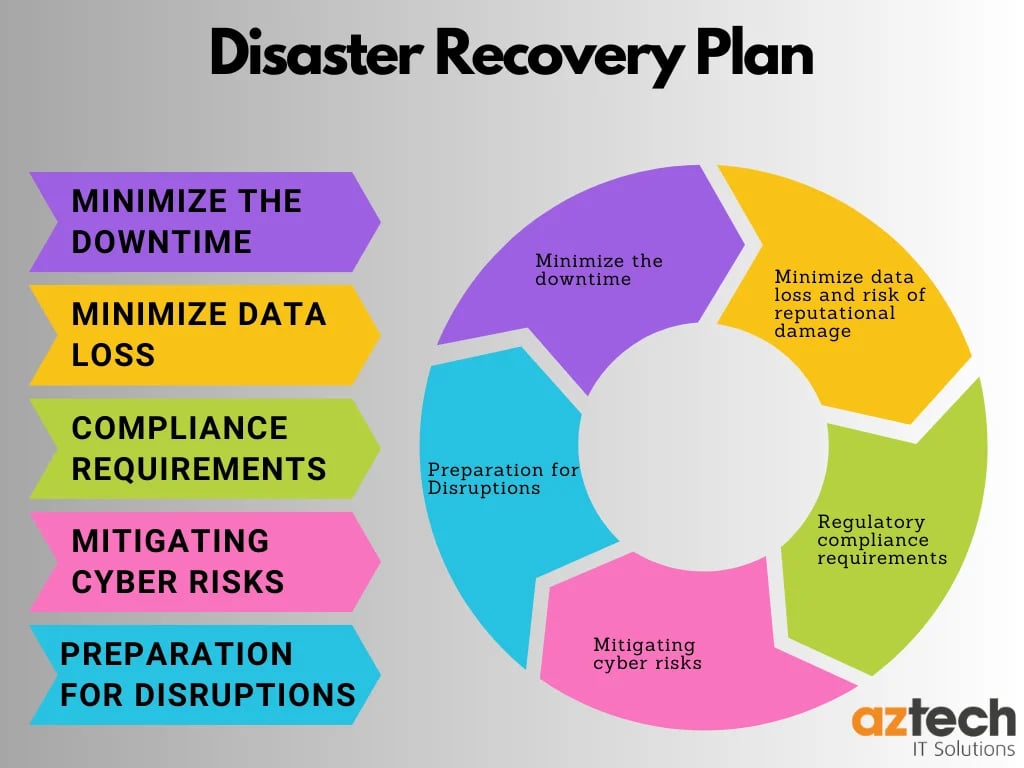
Therefore, it is essential to have a disaster recovery strategy in place to ensure that you can respond quickly and effectively to minimize damages.
1. Minimize the downtime
Firstly, having a disaster recovery process will help to minimize the downtime that a business experiences. In the event of a disaster, data loss or system downtime that negatively affects a business's normal operations, downtime can cost millions of dollars in lost revenue. When your business has a DRP, it allows you to recover operations promptly, minimizing downtime.
2. Minimize data loss and risk of reputational damage
Secondly, your business needs to protect its reputation. Disasters can not only impact your operations but also your reputation. When a company experiences an outage or data loss, it can damage its brand and leave its customers questioning its ability to protect their data. Disaster recovery strategies can help you minimize data loss and minimize the risk of reputational damage.
3. Regulatory compliance requirements
Thirdly, regulatory compliance requirements. Different organizations have diverse regulatory compliance requirements. Many industries are required to maintain specific data retention periods and implement heightened security measures to protect personal data. With a disaster recovery plan in place, you can ensure that you meet these regulations.
4. Mitigating cyber risks
Fourthly, a disaster recovery plans can help mitigate cyber risks. Hackers are continually developing new ways to bypass data security protocols. Cybercriminals can steal data and damage a business's security, causing significant financial losses. Having a DRP that includes cybersecurity measures can help mitigate cybersecurity breaches and protect your valuable data.
5. Preparation for Disruptions
Lastly, businesses cannot predict disruptions but can be prepared for it. Disasters like floods, fires, and hurricanes can cause severe damage to businesses. Many businesses may not survive these events, but having a disaster recovery processes in place can help ensure that you are better prepared to face any disaster.
Scope and objectives of DR planning
Disaster recovery planning (DR planning) is an essential aspect of any organization for business continuity, no matter its size or industry. Its primary objectives are to respond to unplanned incidents, minimize disruptions to business and ensure that data are recoverable after a disaster occurs.
The scope of DR planning typically includes identifying potential risks that could cause disruptions, assessing the impact of these risks, and developing incident management plan and backup procedures that detail how to respond in the event of a disaster.
DR planning also involves testing and updating procedures regularly to ensure that they remain effective. By having a comprehensive DR plan in place, organizations can minimize the impact of disasters and restore normal operations quickly.
Different Types of Disaster Recovery Plans
DRP plans can be customized to suit different environments. Here are some specific types of plans:
1. Virtualized Disaster Recovery Plan
Virtualization offers a more efficient and simplified approach to DR. Within minutes, a virtualized environment can create new virtual machine instances and facilitate application recovery through high availability.
Testing becomes easier, but the plan needs to ensure that applications can be run in DR mode and restored to normal operations within the Recovery Point Objective (RPO) and Recovery Time Objective (RTO).
2. Network Disaster Recovery Plan
As the complexity of a network increases, developing a recovery plan becomes more challenging. It is crucial to have a detailed, step-by-step procedure for network recovery, proper testing, and regular updates.
The plan should include network-specific information, such as performance metrics and details of networking staff involved.
3. Cloud Disaster Recovery Plan
Cloud DR can range from simple file backups in the cloud to complete replication of systems. It offers space, time, and cost efficiencies, but proper management is essential for maintaining the plan.
The plan should address security concerns, which are common in the cloud, through rigorous testing.
4. Data Center Disaster Recovery Plan
This type of plan focuses specifically on the facility and infrastructure of the data center. An operational risk assessment is a critical component of a data center DRP.
It examines key elements such as building location, power systems, security, and office space. The plan should encompass a wide range of potential scenarios.
Phases/Components of Disaster Recovery Plan
Here are four phases or components of a DR Plan:
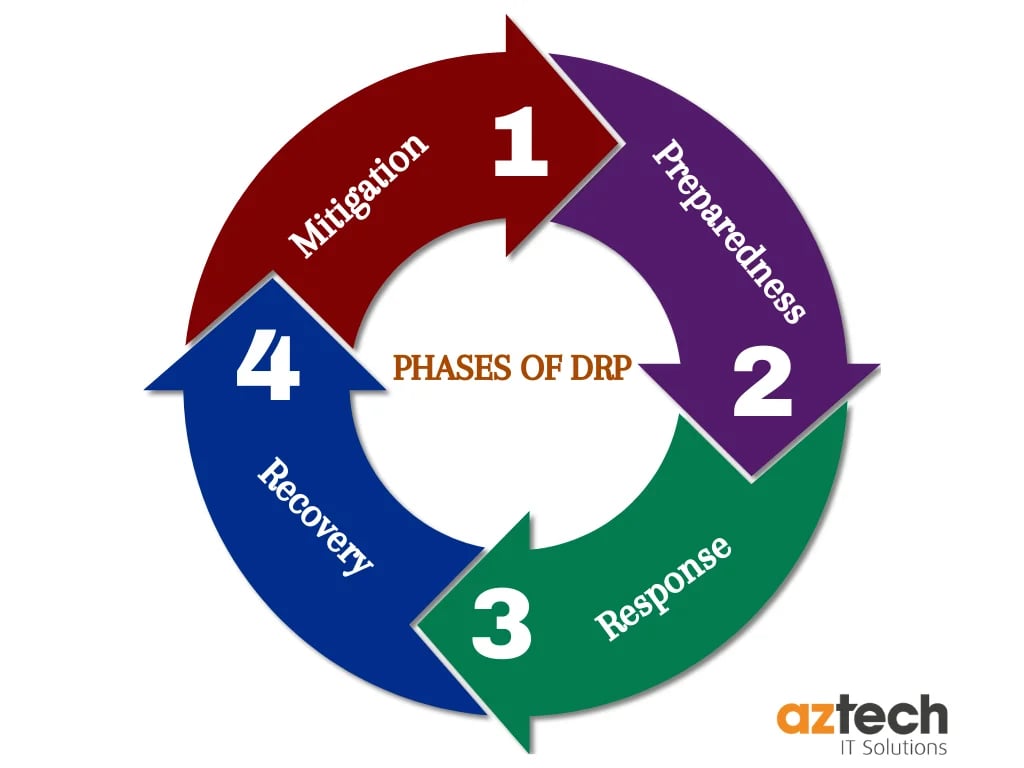
1. Mitigation
This phase involves taking proactive measures to prevent or minimize the causes, impacts, and consequences of disasters.
2. Prevention
This phase includes comprehensive planning, training, and educational activities aimed at preparing for events that cannot be fully mitigated.
3. Response
The response phase takes place immediately after a disaster occurs. During this phase, normal business and other operations are disrupted. Personal safety and well-being in an emergency situation are of utmost importance, and the duration of the response phase depends on the level of preparedness.
4. Recovery
During the recovery period, efforts to restore and recover take place alongside regular operations and activities. The recovery process following a disaster can be lengthy, requiring careful planning and execution to ensure a successful recovery and return to normalcy.
Simple Disaster Recovery Plan example for Small Businesses
As a small business owner, it's important to have a DR plan in place in case the unexpected strikes. Fortunately, creating a simple disaster plan doesn't have to be complicated or time-consuming. You can download the disaster recovery plan template pdf below for free and get in touch with us for disaster recovery services.
By identifying potential risks, backing up your data, and having a backup location for important documents, you'll be better equipped to handle any situation that arises. With a little bit of planning, you'll have peace of mind knowing you're prepared for the worst.
Effective Disaster Recovery Plan Examples
Here are three examples of an effective Disaster Recovery Planning:
1. Walmart Disaster Recovery Plan

Walmart has one of the most effective disaster recovery plans examples in place. The company has designed its DRP to ensure the safety of its customers, employees, and business operations.
Walmart has a dedicated team that is responsible for assessing the damage caused by a disaster, prioritizing the most critical components, and ensuring a speedy recovery of its systems and data.
Walmart has made significant investments in its DR plan, including building their own data centers, hiring disaster experts, and investing heavily in backup and recovery solutions.
2. American Red Cross Disaster Recovery Plan

The American Red Cross is one of the great disaster recovery plan examples. The organization has a comprehensive recovery strategies that is designed to respond quickly to natural disaster strikes, develop recovery strategies and disaster recovery processes to work with local communities to provide post-disaster relief.
Their DRP includes a team of volunteers, supplies and resources that are strategically placed in areas that are most prone to disasters.
The organization's DRP is reviewed regularly, and new procedures and protocols are updated as per changing requirements.
3. IBM Disaster Recovery Plan
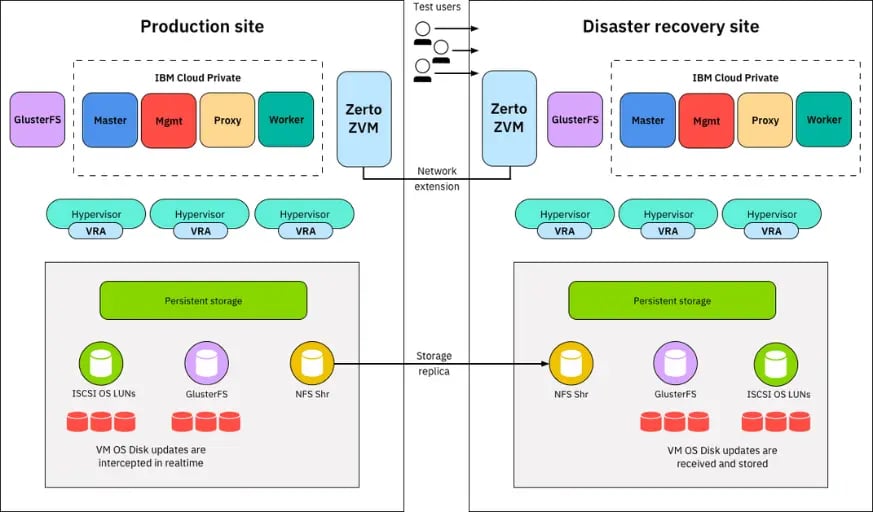
IBM is a leading provider of disaster recovery solutions and has its own effective disaster plan in place for its business operations. IBM's DRP is designed to keep its employees safe and protect its business operations during a disaster.
IBM offers continuous availability of its critical applications and data, replication technology to backup and restore critical data, and redundant data centers in case of a disaster.
IBM's DRP also includes its team of onsite and offsite professionals who provide support in the event of a disaster.
Disaster Recovery Plan Template
You can create an effective disaster recovery plan template with the help of these tips below. Also, you can find the DR plan template PDF version here and download it for free.
Download Disaster Recovery Plan Template PDF and Sample for Free.
How to create an effective Disaster Recovery Plan
A well-crafted disaster recovery plan template ensures businesses can quickly restore their systems and resume operations as soon as possible for business continuity.
Now, we will take a look at the key elements that need to be included to build an effective Disaster plan template.
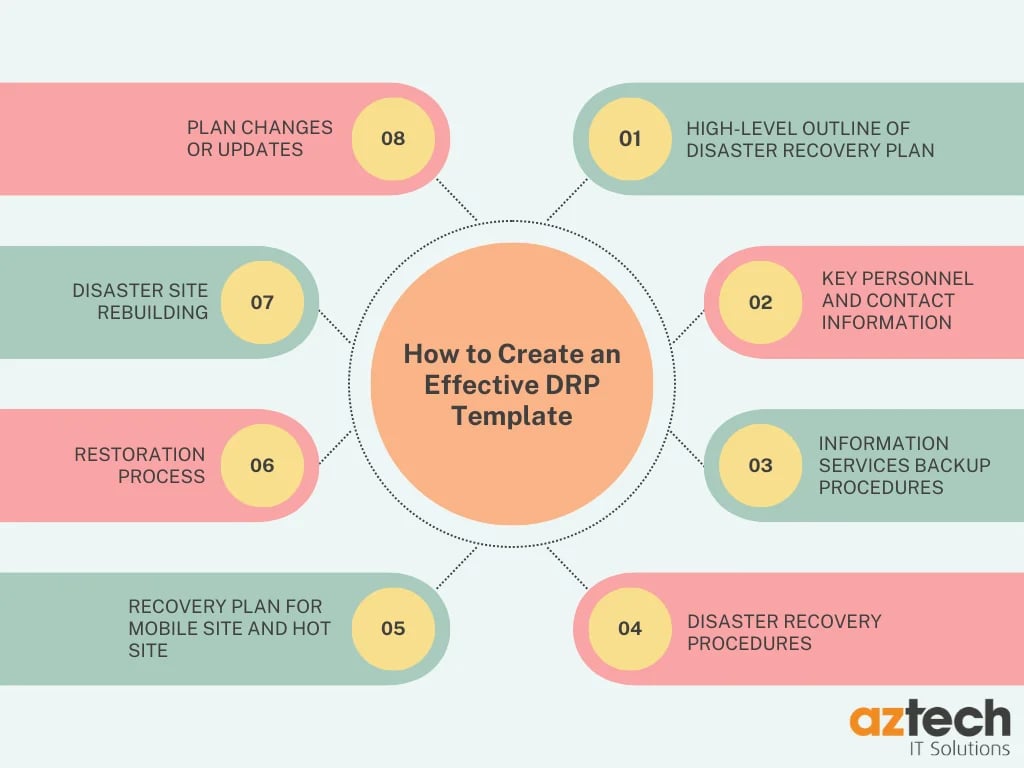
1. Risk Assessment
The first step in creating an effective DR plan is to conduct a comprehensive risk analysis and business impact analysis . Identify the systems and processes that are critical to the organization's operations and their vulnerabilities. Also, it is vital to consider the level of risk each vulnerability poses in terms of disruption and downtime.
2. Emergency Response Procedures
Next, you need to include detailed emergency response procedures in your plan. This should include both an evacuation plan and steps for IT recovery. Your disaster recovery plan template should have a clear, concise set of instructions for dealing with various potential crises, such as cyber-attacks, power outages, or natural disasters and disaster site rebuilding process.
3. Backup and Recovery
One of the essential elements of a disaster recovery plan template is having reliable backup, recovery strategies and recovery procedures. This means creating a complete redundancy of all critical data and systems, including offsite backups. Always ensure to have a schedule for conducting backups, as well as outlining procedures for restoring data to their original locations.
4. Communication Plan
During a crisis, communication is critical. All stakeholders should be updated immediately there is a disruption. The communication plan should include designated personnel with emergency contact information and a defined chain of command to ensure that messages reach the appropriate people in a timely manner.
5. Ongoing Testing and Maintenance
Last but not least, it is vital to test and maintain your disaster recovery procedure regularly.
This means reviewing the plan annually to identify and update any outdated or incomplete areas.
You should also conduct regular practice drills to ensure that team members understand their roles and responsibilities during a crisis.
Ongoing testing will improve your plan's effectiveness and ensure you can respond quickly and effectively.
Conclusion
At AZTech, we have 15 plus years of experience in supporting our clients with all aspects of IT security and continuity.
So, if you would like a no-obligation chat with one of our disaster recovery team regarding how you can formulate a Disaster Recovery Plan for your company, get in touch with us today, and we would be happy to help you.

-1.png?width=552&height=678&name=text-image%20module%20desktop%20(4)-1.png)


.png?width=2000&name=Case%20study%20(21).png)


-2.png?width=422&height=591&name=text%20image%20tablet%20(31)-2.png)



